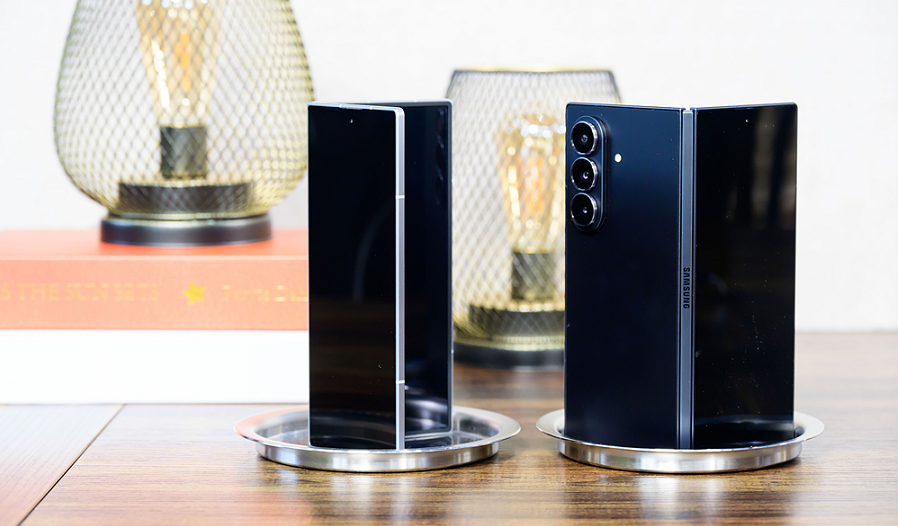 APPS
APPS
 APPS
APPS
 APPS
APPS
Samsung Electronics Co. today debuted three Galaxy Z handsets that can fold in half and two additions to its Galaxy Watch smartwatch series.
The device lineup is headlined by the Galaxy Z Fold 7, a $1,999 foldable equipped with Qualcomm Inc.’s top-end Snapdragon 8 Elite chip. The other new gadgets feature Samsung processors. Most of those processors were made with the company’s latest three-nanometer manufacturing node, which uses gate-all-around transistors.
The Fold 7 is a tablet that can fold like a book to turn into a smartphone. In tablet mode, the device activates its eight-inch main display, which is slightly larger than the previous-generation Fold 6’s panel. In smartphone mode, users have access to a 6.5-inch screen on the device’s external cover. That display is not only larger than its predecessor but also offers a significantly higher resolution.
Samsung removed the main display’s support for its S Pen stylus to make it thinner. As a result, the Fold 7 is 8.9 millimeters thick when folded, a 30% improvement over its predecessor. It’s also less susceptible to water damage.
The Fold 7’s casing hosts not only two displays but also five cameras. There’s a selfie camera next to each screen, as well as an ultrawide lens and a telephoto sensor for zooming in. The primary camera on the device’s exterior features a resolution of 200 megapixels, four times what the Fold 6 offered.
The Fold 7 is powered by a Qualcomm chip called the Snapdragon 8 Elite that debuted last year. It includes a central processing unit with two prime cores, which are optimized for performance, and six smaller cores that trade off some speed for lower power usage. There’s also a graphics processing unit and an artificial intelligence accelerator.
The two other foldable devices that Samsung debuted today, the Galaxy Z Flip 7 and the Galaxy Z Flip 7 FE, feature a design inspired by flip phones. Both devices are smartphones that can fold vertically into a rectangular form factor.
The Flip 7, the more capable of the two devices, features a 6.9-inch primary display and a 4.1-inch external display. The latter screen, which activates when the handset is folded, is significantly larger than the one in Samsung’s previous-generation device. It can be used to access Google’s Gemini AI assistant and perform a limited number of other tasks.
The Flip 7 is powered by a Samsung-made Exynos 2500 processor. Like Qualcomm’s Snapdragon 8 Elite, it’s a system-on-chip that combines a CPU with a GPU and an AI accelerator. There’s also an onboard modem that supports satellite internet.
Samsung’s other new vertically-folding smartphone is the Flip 7 FE. It will sell starting from $899, or $300 less than the standard Flip 7. The device features a smaller external display and a less advanced processor.
Samsung is rolling out the new foldables alongside two additions to its smartwatch portfolio. The Galaxy Watch 8 and the Galaxy Watch 8 Classic both feature a 1.34-inch circular display set in a rectangular bezel. They also use the same Exynos W1000 chip, which is made using the same three-nanometer node as the Exynos 2500 chip in the Flip 7.
The primary difference between the devices is their storage capacity. The Watch 8 can hold up to 32 gigabytes of data while the Watch 8 Classic accommodates twice as much. Additionally, the latter device’s battery capacity and display resolution are slightly better.
Support our mission to keep content open and free by engaging with theCUBE community. Join theCUBE’s Alumni Trust Network, where technology leaders connect, share intelligence and create opportunities.
Founded by tech visionaries John Furrier and Dave Vellante, SiliconANGLE Media has built a dynamic ecosystem of industry-leading digital media brands that reach 15+ million elite tech professionals. Our new proprietary theCUBE AI Video Cloud is breaking ground in audience interaction, leveraging theCUBEai.com neural network to help technology companies make data-driven decisions and stay at the forefront of industry conversations.